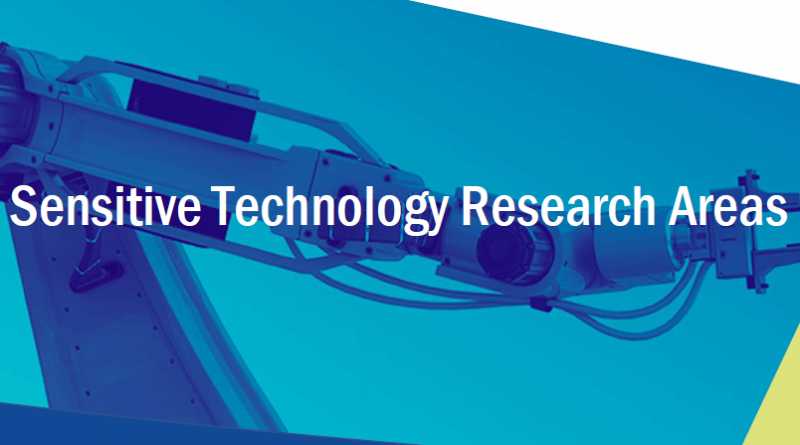Canada’s Sensitive Technology Research Areas
2. Advanced Energy Technology
Advanced energy technology refers to technologies and processes that enable improved generation, storage and transmission of energy, as well as operating in remote or adverse environments where power sources may not be readily available, but are required to support permanent or temporary infrastructure and power vehicles, equipment and devices.
Advanced energy storage technology
Technologies that store energy, such as batteries, with new or enhanced properties, including improved energy density, compact size and low weight to enable portability, survivability in harsh conditions and the ability to recharge quickly. Examples include: fuel cells, novel batteries (biodegradable batteries; graphene aluminium-ion batteries; lithium-air batteries; room-temperature all-liquid-metal batteries; solid-state batteries; structural batteries) and supercapacitors (or ultracapacitors).
Advanced nuclear generation technology
New reactors and technologies that are smaller in size than conventional nuclear reactors and are developed to be less capital-intensive, therefore minimizing risks faced during construction. Examples include: nuclear fusion and small modular reactors.
Wireless power transfer technology
Enables the transmission of electricity without using wire over extended distances that vary greatly and could be up to several kilometres. Examples include recharging zones (analogous to Wi-Fi zones) that allow for electric devices, such as vehicles, to be recharged within a large radius, as well as for recharging space-based objects, such as satellites.
3. Advanced Materials and Manufacturing
Advanced Materials
Advanced materials refer to high-value products, components or materials with new or enhanced structural or functional properties. They may rely on advanced manufacturing processes or novel approaches for their production.
Augmented conventional materials
Conventional materials such as high strength steel or aluminum and magnesium alloys – products that are already widely used – which are augmented to have unconventional or extraordinary properties. Examples of these properties could include improved durability or high temperature strength, corrosion resistance, flexibility, weldability, or reduced weight, among others.
Auxetic materials
Materials that have a negative Poisson’s ratio, meaning that when stretched horizontally, they thicken or expand vertically (rather than thinning as most materials do when stretched), and do the opposite when compressed horizontally. These materials possess unique properties, such as energy-absorption, high rigidity, improved energy/impact absorption and resistance to fracture.
High-entropy materials
Special materials, including high-entropy alloys, high-entropy oxides or other high-entropy compounds, comprised of several elements or components. Depending on their composition, high-entropy materials can enhance fracture toughness, strength, conductivity, corrosion resistance, hardness and other desired properties. Due to the breadth of the theoretically available combinations and their respective properties, these materials can be used in several industries, including aerospace. Additionally, high-entropy oxides are being considered for applications in energy production and storage, as well as thermal barrier coatings.
Metamaterials
Structured materials that are not found or easily obtained in nature. Metamaterials often have unique interactions with electromagnetic radiation (i.e. light or microwaves) or sound waves.
Multifunctional/smart materials
Materials that can transform in response to external stimuli (e.g. heat, water, light, etc.) within a given amount of time. Examples include: magnetorheological fluid, shape memory alloys, shape memory polymers and self-assembled materials.
Nanomaterials
Nanomaterial materials have dimensions of less than 100 nanometers and exhibit certain properties or unique characteristics such as increased durability or self-repair. A subset of nanomaterials, nano-energetic materials are energetic materials synthesized and fabricated at the nano-level that have a small particle size and high surface area between particles, which enable faster or more efficient reaction pathways when exposed to other substances.
Powder materials for additive manufacturing
Powders that typically consist of metal, polymer, ceramic and composite materials. These powders enable additive manufacturing processes, also referred to as 3D printing. Research into novel powder materials can lead to manufactured parts with enhanced mechanical properties and other desired characteristics.
Superconducting materials
Materials that can transmit electricity with no resistance, ultimately eliminating power losses associated with electrical resistivity that normally occurs in conductors. Manufacturing of superconducting electronic circuits is one of the most promising approaches to implementing quantum computers.
Two-dimensional (2D) materials
Materials with a thickness of roughly one atomic layer. One of the most well-known 2D materials, for which there are currently production/fabrication technologies, is graphene. Other examples of 2D materials include: silicene, germanene, stantene, metal chalcogenides and others, which are currently being researched with potential applications in sensors, miniaturized electronic devices, semiconductors and more.
Advanced Manufacturing
Advanced manufacturing refers to enhanced or novel technologies, tools and processes used to develop and manufacture advanced materials or components. This could include using specialized software, artificial intelligence, sensors and high performance tools, among others, to facilitate process automation or closed-loop automated machining and create new materials or components.
Additive manufacturing (3D printing)
Various processes in which solid three-dimensional objects are constructed using computer-aided-design (CAD) software to build an object, ranging from simple geometric shapes to parts for commercial airplanes. 3D printing could be used to accelerate the development through rapid prototyping of customized equipment, spare tools or novel shapes or objects that are stronger and lighter. Approaches are also being developed for multi-material additive manufacturing and volumetric additive manufacturing, as well as additive manufacturing for repair and restoration.
Advanced semiconductor manufacturing
Methods, materials and processes related to the manufacturing of semiconductor devices. Examples of techniques include: advancements in deposition, coating, lithography, ionization/doping, and other core and supporting processes, such as thermal management techniques. Recent technological advancements include developments in Extreme Ultraviolet (EUV) lithography, which is an advanced method for fabricating intricate patterns on a substrate to produce a semiconductor device with extremely small features.
Critical materials manufacturing
Up and midstream technologies necessary to extract, process, upgrade, and recycle/recover critical materials (e.g. rare earth elements, scandium, lithium, etc.) and establish and maintain secure domestic and allied supply chains. More information about critical minerals can be found in Canada’s Critical Minerals List.
Four-dimensional (4D) printing
Production and manufacture of 3D products using multifunctional or “smart” materials that are programmed to transform in response to external stimuli (e.g. heat, water, light, etc.) within a given amount of time. Recent developments have also been made in creating reversible 4D printed objects, which can return to their original shape without human involvement.
Nano-manufacturing
Production and manufacture of nanoscale materials, structures, devices and systems in a scaled-up, reliable and cost-effective manner.
Two-dimensional (2D) materials manufacturing
Standardized, scalable and cost-effective large-scale production of 2D materials.





